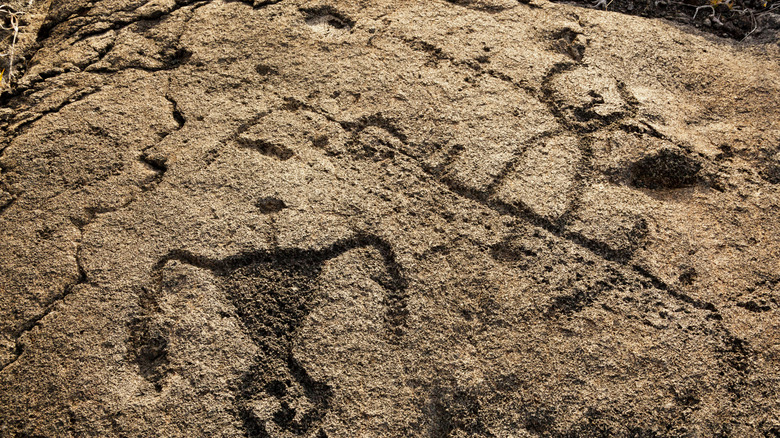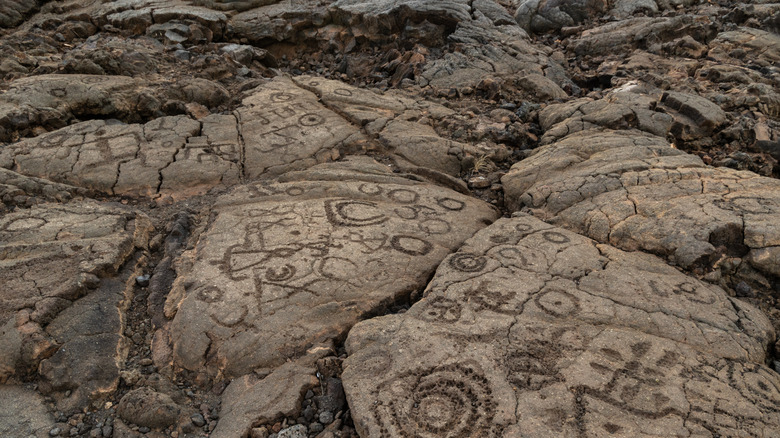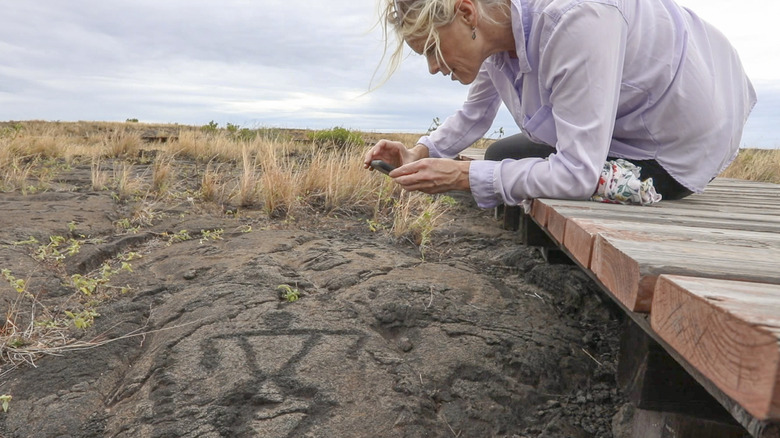The Unexpected State In America Where You Can Find Plenty Of Petroglyphs
When you think of where you can find petroglyphs (images carved into rock), you might think of a destination somewhere in the southwest, like Albuquerque, New Mexico or the national parks of southern Utah. But you can also find them in Hawaii, and while they can be found on many of the inhabited islands, they're most notable on the Big Island.
The Hawaiian word for petroglyphs is ki'i pōhaku, meaning "image stone," and it was one of the only forms of written communication in Hawaii for a long time; stories were passed along through spoken word and dance. We don't know the exact meaning for the petroglyphs, but some theories and interpretations are that they were used to mark momentous occasions or were connected to performing some kinds of spiritual rituals.
They're typically found close to boundaries between places and in places that were thought to have "mana" or a special energy to them. You can find some that are uniquely Hawaiian, like turtles, canoes, and even surfboards, along with more universal symbols like human figures and circles. The best time of day to see them is early in the morning or later in the afternoon when shadows help the carvings stand out more and when it's not quite as hot; many of them are in exposed areas without trees and where the lava rock reflects heat back at you.
Waikoloa Beach Marriott Resort & Spa gives easy access to many of Hawaii's petroglyphs
One of the easiest places to see them on the Big Island is at the Waikoloa Petroglyph Preserve, about a 25 minute drive from the Kona airport. The preserve is at the border between what were the Kohola and Kona kingdoms, which has led some to hypothesize that crossing that border played a role in why there is such a concentration of petroglyphs here, and there are thousands of them. They range from dots and circles to a figure on horseback to English language letters, and they date from 840 to 1900.
The preserve is set between two golf courses, giving it a bit of a surreal feel. It's a short, easy trail that takes you through the petroglyphs, but you'll be walking on lava rock, so wear sturdy shoes. Make sure to stay on the trail to help preserve the carvings.
If you stay at the Waikoloa Beach Marriott Resort & Spa, you'll less than half a mile away from the Waikoloa Petroglyph Preserve, plus, there are some petroglyphs on the hotel property. If you go on one of the hotel's free cultural walking tours for guests, your guide will point them out. You'll also learn about the traditional fishponds at the resort, and you'll see an ancient house platform built from lava stone, which will help you understand more about the people who once lived here and may have carved the petroglyphs you can still see today.
Petroglyphs can be found on both the east and west sides of the Big Island
Another good spot is the Puakō Petroglyph Archaeological Preserve near the Fairmont Orchid; it's just about a 10-minute drive from the Waikoloa petroglyphs. There are more than 3,000 carvings here, and the 1.5 mile long Malama Trail will take you through a part of the 223-acre preserve. Closed toe shoes would be a good idea here since the unpaved portion of the trail runs near kiawe trees, which have long, sharp spikes. Along your walk, you can see images of turtles, canoe sails, people, and more.
On the other side of the island in Hawaii Volcanoes National Park, one of the best national parks on an island, you can find tens of thousands of petroglyphs at Puʻuloa, which means "hill of long life" in Hawaiian. To see them, take the 1.5 mile out and back trail, which is partially along lava and partially on a boardwalk. In 1823, a missionary to the island wrote about seeing the petroglyph field and gave us some insight into what they could mean: "On inquiry, we found that they had been made by former travelers, from a motive similar to that which induces a person to carve his initials on a stone or tree, or a traveler to record his name in an album, to inform his successors that he had been there," according to the National Park Service. So, if you're a fan of history and culture, add these sites to your list of things to do on the Big Island. It's a unique experience that gives some insight into the Hawaiians who've lived there for centuries.


